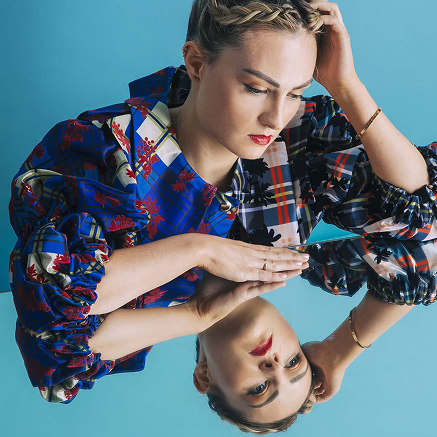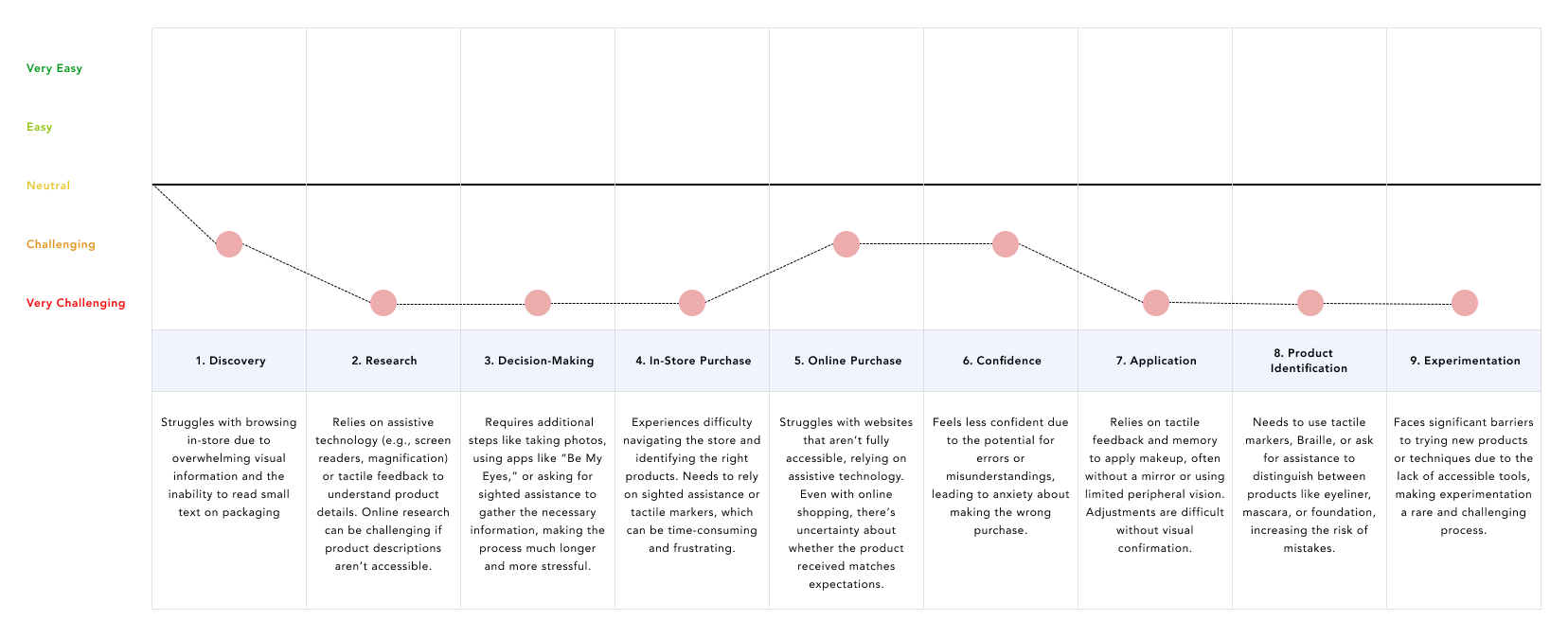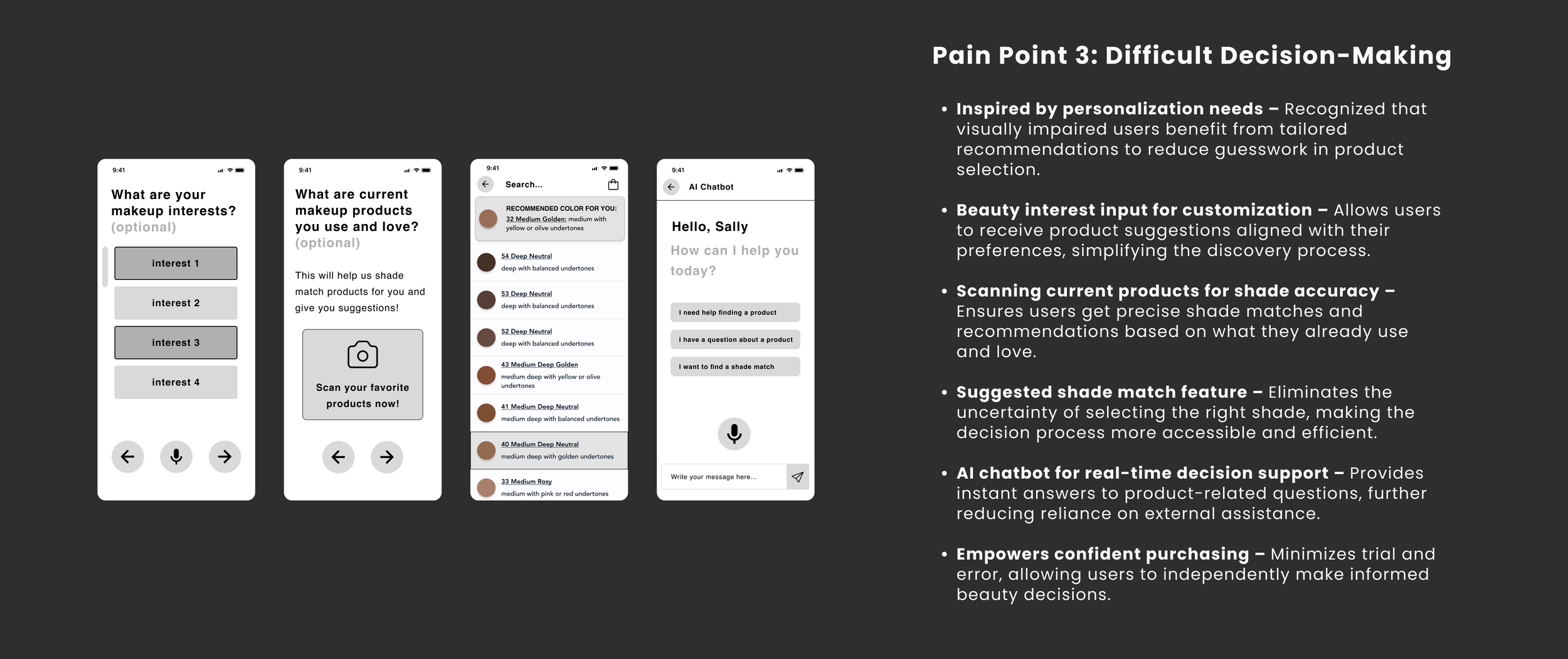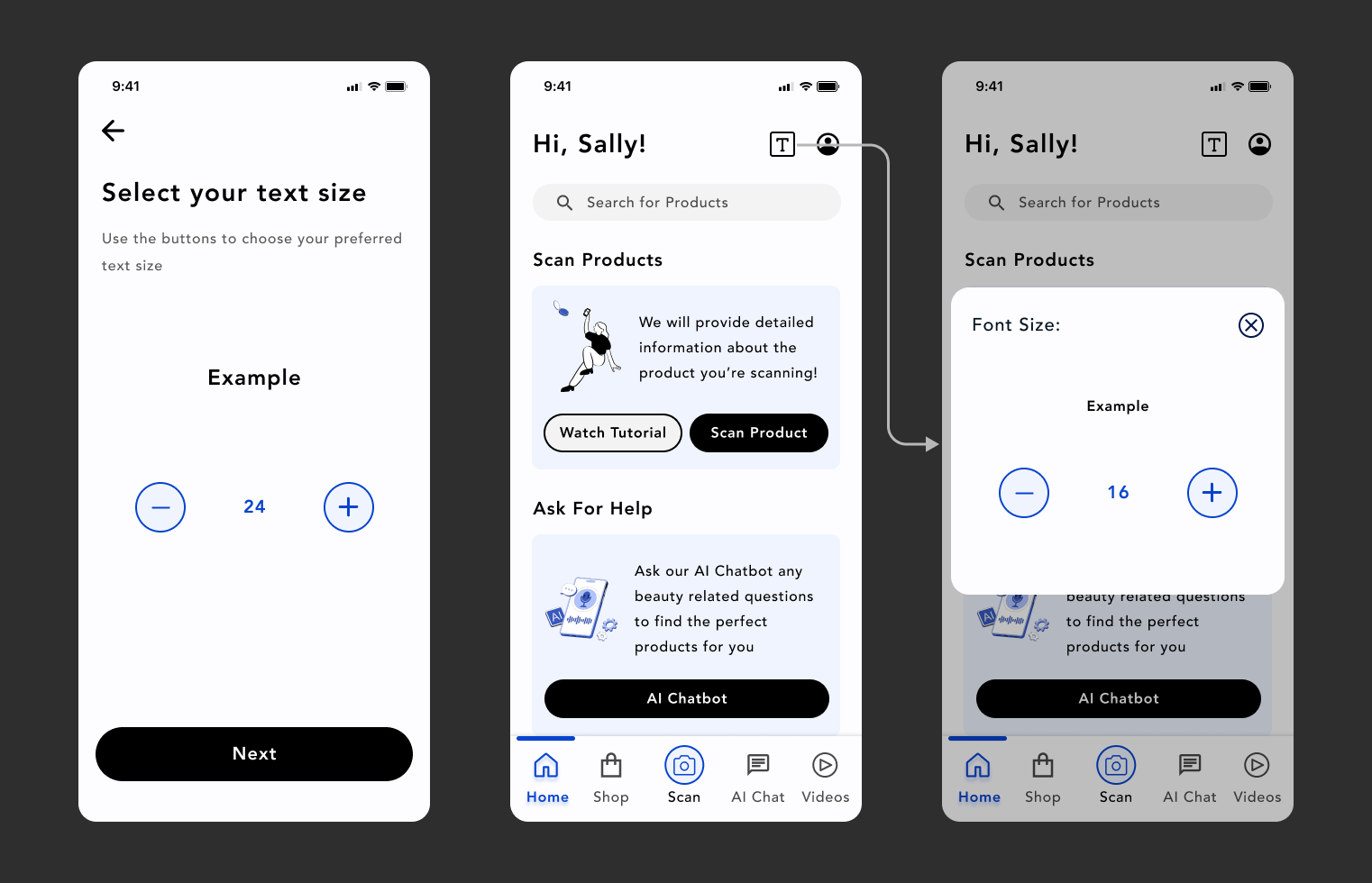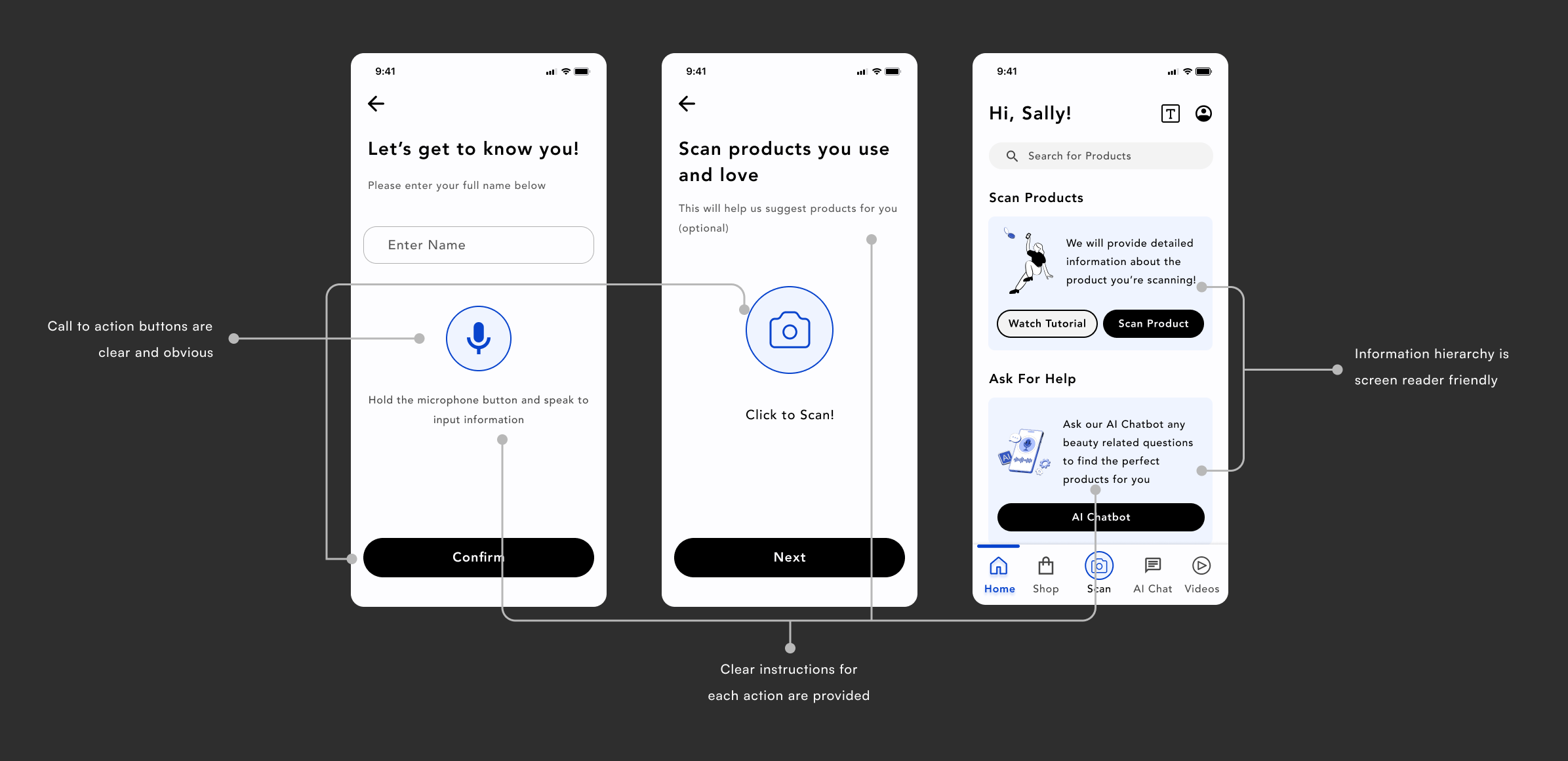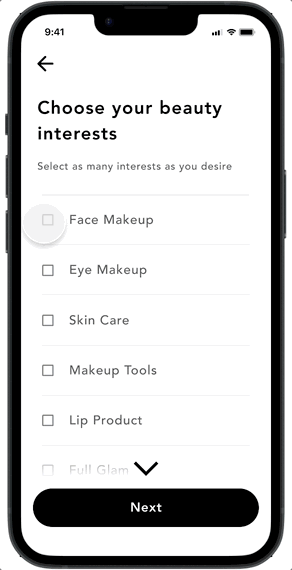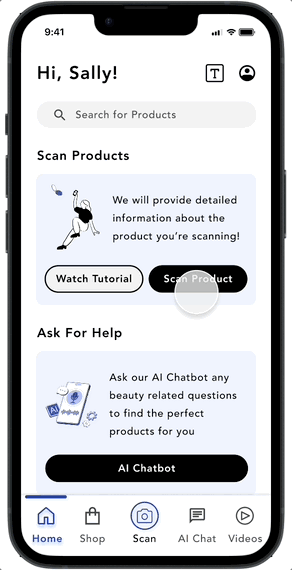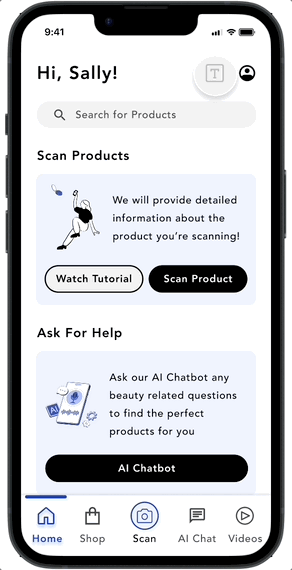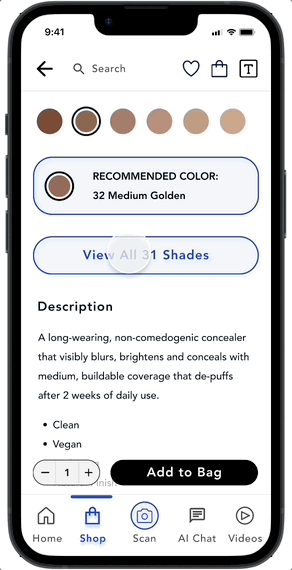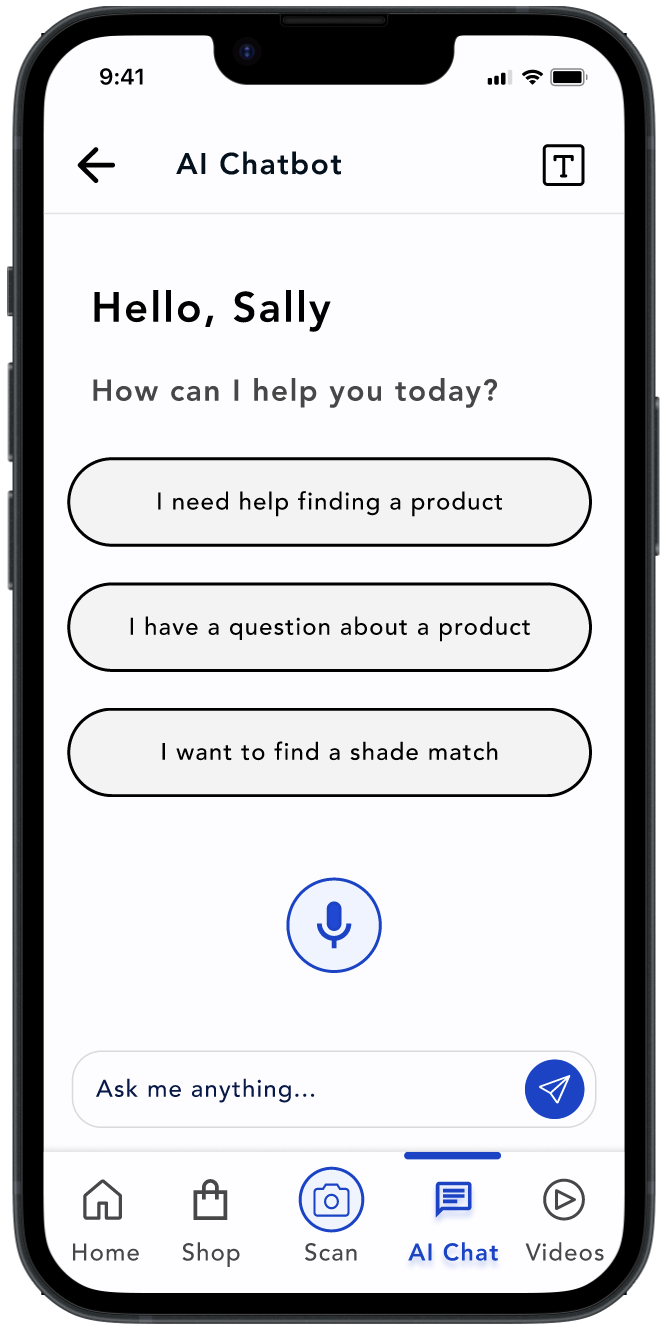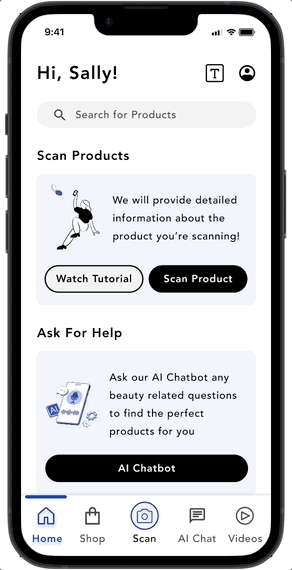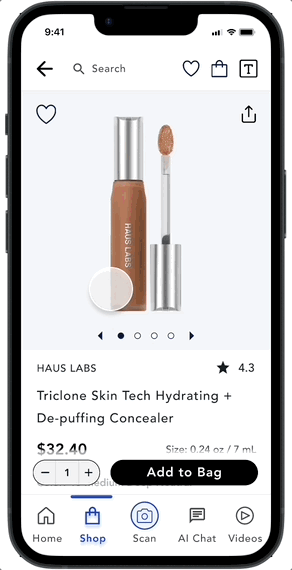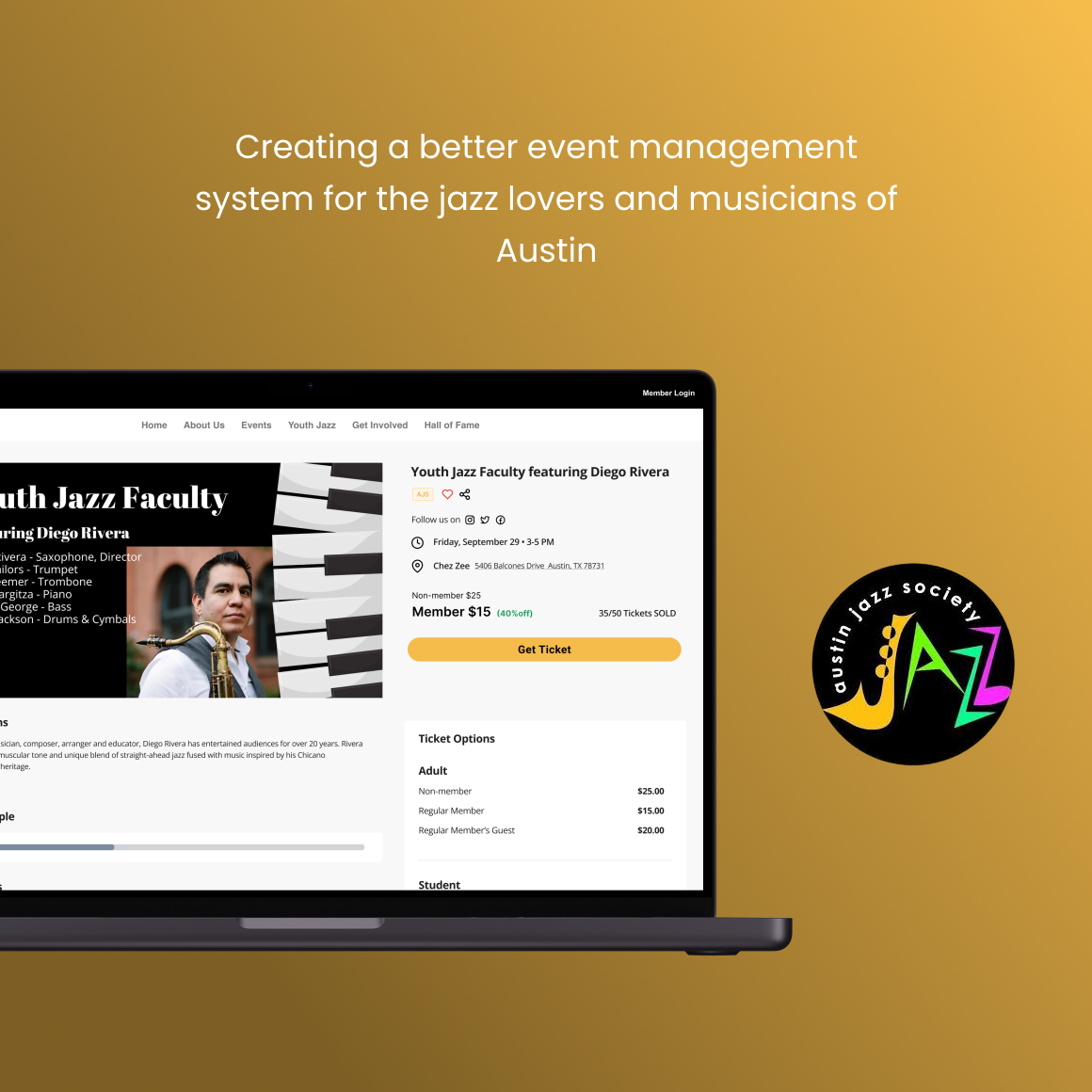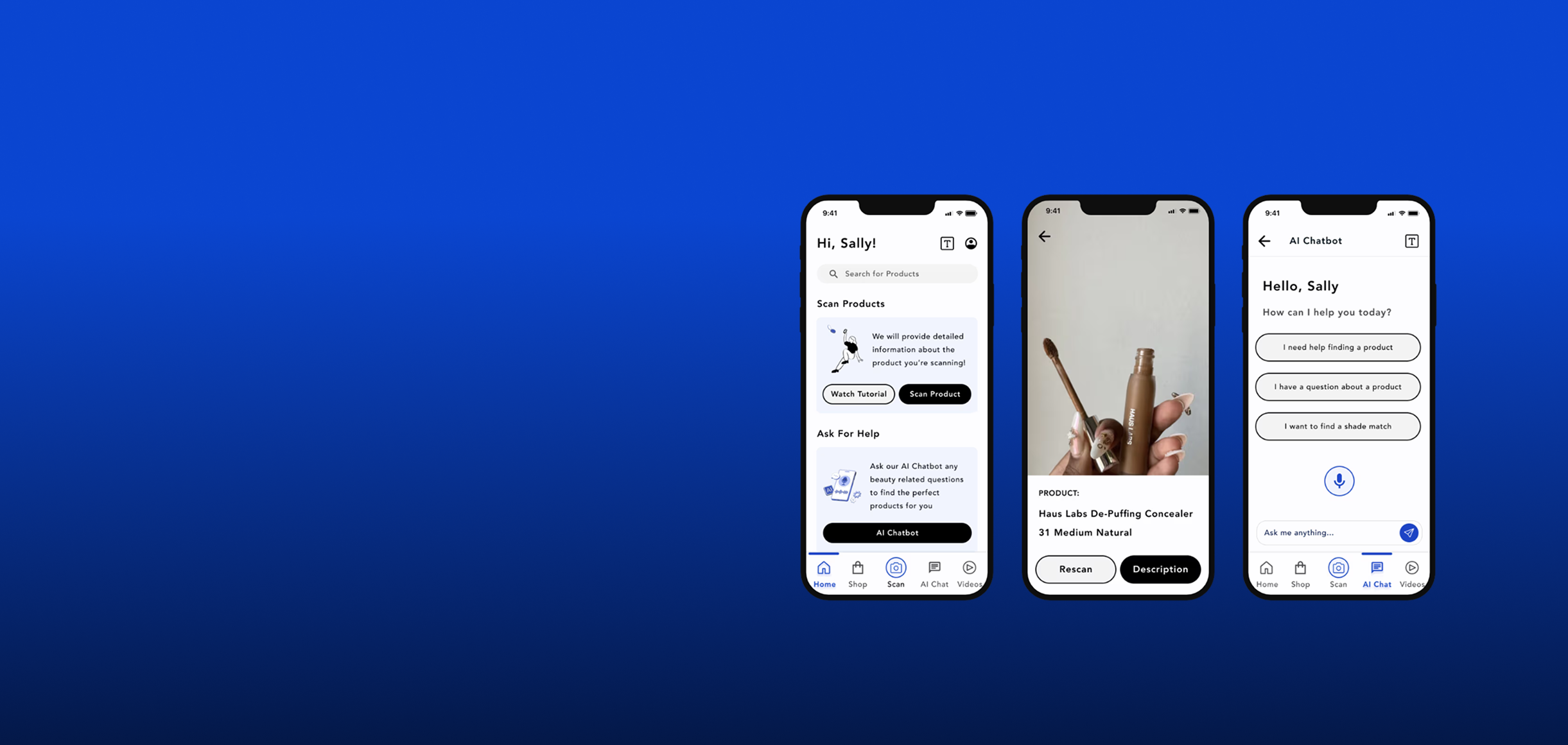
Visiglam
An app that makes beauty accessible to visually impaired individuals
Overview
This app is a personal project inspired by a design accessibility class, aiming to address the significant accessibility gap in the beauty industry. It empowers visually impaired individuals to shop for and apply makeup independently through voice guidance, AI assistance, and accessible product recommendations. By focusing on inclusivity, this project seeks to make beauty more accessible to everyone.
My Role
I worked as the sole UX designer and UX Researcher for the passion project
Scope
UX Designer, UX Researcher, Prototyping
Timeline
3 Months, Started February 2024
The beauty industry lacks accessible tools that enable visually impaired individuals to independently discover, learn about, and apply makeup, limiting their autonomy and self-expression.
THE PROBLEM
Create an application that empowers visually impaired individuals to have full independence over their beauty process
GOAL
How might we…
1
Make it easier for visually impaired users to identify and select makeup products that suit their preferences and needs without relying on visual cues.
2
Provide clear, step-by-step guidance for makeup application to help users feel confident and independent throughout the process.
3
Incorporate personalized features that adapt to individual users’ beauty routines and preferences, ensuring a seamless and tailored experience.
4
Create an intuitive and accessible interface that empowers users to navigate and interact with the app effortlessly, fostering autonomy and independence.
What barriers do visually impaired individuals face when independently discovering and applying makeup?
RESEARCH
STATISTICS
The beauty industry remains largely inaccessible to visually impaired individuals, despite progress in inclusive products. Limited tools for product identification, intuitive information access, and independent application force reliance on others, reducing autonomy. This gap creates both practical challenges and a sense of exclusion in a space meant for self-expression.
How big is this problem?
2.2 billion
visually impaired individuals globally
$348 billion
market of blind individuals that has been overlooked by the cosmetic industry
95.1%
of visually impaired individuals felt there were not enough accessible beauty brands
10%
of businesses have a "targeted strategy" to accommodate blind people
I explored numerous articles, blogs, and videos to gain a deeper understanding of the frustrations visually impaired individuals face when it comes to beauty. This ensures that my design solutions are informed by real experiences rather than assumptions.
Understanding the frustrations of visually impaired individuals
USER RESEARCH
Visually impaired users struggle to distinguish between makeup products.
Navigating makeup stores is overwhelming for visually impaired individuals as identifying products is difficult.
Many websites lack accessible features, making it challenging to find and purchase the right makeup products online.
Applying makeup independently is difficult without visual feedback, leading users to rely on tactile cues, memory, or external help to avoid mistakes.
Visually impaired users need guidance to apply makeup effectively, limiting their ability to customize their look independently.
Molly Burke, a blind beauty YouTuber with 1.97 million subscribers, has collaborated with major beauty brands to advocate for the blind community. I watched several of her videos to better understand visual impairment and gain insight into her daily experience using beauty products.
Immersing myself in the experience
Molly sheds light on the many design flaws in beauty products that create unnecessary barriers for visually impaired users. Below are key gaps in the industry that hinder accessibility and independence:
I looked at the user journey of a sighted individual
COMPARING USER JOURNEYS
The user journey is straightforward, quick, and confidence-driven, with minimal barriers from discovery to application.
I compared this to the user journey of a visually impaired individual
The journey is complex, time-consuming, and fraught with challenges at every stage, from product discovery and purchase to application. The process often requires external assistance, specialized tools, and added steps, leading to a less independent and more stressful experience.
RESEARCH FINDINGS
These challenges prevent visually impaired individuals from independently navigating the beauty process, forcing reliance on others and limiting self-expression.
RESEARCH FINDINGS
Narrowing down on pain points
Through my research, I uncovered a wide range of frustrations, but I noticed they all traced back to three key pain points. These became the foundation of my focus because if we could solve these core challenges, many of the other struggles would naturally begin to fall into place.
1. Product Identification
Difficulty distinguishing and identifying makeup products independently creates unnecessary reliance on others.
2. Application Challenges
Lack of clear, tailored instructions for applying makeup leads to frustration and decreased confidence.
3. Difficult Decision-Making
Limited access to information and guidance makes comparing and selecting products suited to individual needs difficult.
Ideation
I focused on transforming research insights into intuitive, accessible design solutions that empower visually impaired users to independently navigate, select, and apply beauty products with confidence.
Wireframes
Given the need for a highly detailed approach to visual impairment, I focused on key factors to ensure the most seamless and accessible experience for users.
Accessibilty
Ensuring text is clear, legible, and accessible for users with varying degrees of visual impairment.
TEXT
The onboarding screen allows users to select their preferred text size from the start.
In-app text size can be adjusted anytime via a text box in the top right corner.
Ensured a minimum text size of 16px with flexibility for varying visual impairments.
Testing contrast ratios throughout the design process is critical to ensure text, buttons, and visuals are easily distinguishable for users with low vision, creating a more empowering, user-friendly experience that boosts confidence and fosters autonomy.
Testing WCAG AA and WCAG AAA contrast ratio regulations
COLOR
Seamless and intuitive navigation is key for visually impaired users to independently explore the app with ease.
NAVIGATION
Accessible design elements were integrated throughout the app to simplify usage and support a more self-sufficient experience for visually impaired users.
ACCESSIBLE DESIGN
Creating visual simulations of how users with different visual impairments see the screen is essential for identifying issues with readability, contrast, and layout. These simulations help us ensure the interface remains accessible, intuitive, and effective for all users, leading to a more inclusive product.
Simulating various visual impairments
VISUAL SIMULATIONS
THE FINAL DESIGN
Introducing VisiGlam…
Onboarding
Solution 1: Seamless Product Identification
Quick Scan Feature: Enables users to instantly identify makeup products by scanning them, eliminating the need to rely on visual cues or external assistance.
Detailed Product Descriptions: Provides accessible information about the scanned product, helping users make informed decisions independently.
In-Depth Product Page: Offers comprehensive details such as shade matches, usage instructions, reviews, Q&As, and video tutorials, empowering users to understand and choose products that meet their needs fully.
Suggested Tools for Application: Recommends tools tailored to the specific product, supporting users in applying makeup confidently and effectively.
Adjustable Text Size: Allows users to customize text size for readability, ensuring accurate and easy access to product information without frustration.
Solution 2: Tailored Guidance for Makeup Application Process
In-Depth "How to Use" Section: Provides step-by-step instructions tailored to various looks, giving users clear guidance to confidently apply makeup independently.
Review and Q&A Section: Connects users with visually impaired peers to share personalized tips and advice, offering practical insights for applying products effectively.
AI Chatbot Assistance: Allows users to ask any makeup-related questions and receive instant, tailored guidance, ensuring they have support during the application process.
Video Tutorials: Features videos designed specifically for visually impaired users, demonstrating application techniques in an accessible and easy-to-follow manner.
Community Section: Offers blogs, articles, and podcasts with expert tips and peer advice, fostering a supportive environment where users can learn and grow their skills.
Holistic Support System: Combines personalized guidance, peer insights, and expert advice to empower users to apply makeup without external assistance confidently.
Solution 3: Provide Tools Needed for Users to Make Their Own Beauty-Related Decisions
Personalized Homepage: Centralizes features like product scanning, AI chatbot assistance, shopping, and video tutorials, giving users easy access to tools that support independent decision-making.
Seamless Product Scanning: Enables users to scan products while shopping in person to instantly access thorough information, empowering informed and confident purchasing decisions.
AI Chatbot Assistance: Offers instant answers to product-related questions, helping users evaluate options and make decisions without external reliance.
In-Depth Product Pages: Provides detailed insights into scanned or browsed products, including shade matches and personalized recommendations, ensuring users feel confident about their choices.
Onboarding Product Preferences: Allows users to input their favorite makeup products and preferences, streamlining recommendations and shade matching for new purchases.
Enhanced Decision-Making Tools: Equips users with a combination of accessible features to independently evaluate, compare, and select beauty products that suit their needs.
What I Learned…
Challenge Assumptions
Throughout the development process, I realized that my initial assumptions about how users interact with products often overlooked key accessibility needs. This experience reinforced the importance of conducting early and continuous user research, as well as ongoing testing with the target audience, to create truly inclusive designs.
Holistic Design Consideration
The design process for accessible products must consider the entire user journey, from discovery to application, ensuring that every touchpoint is intuitive, functional, and empowering.
Technology as an Equalizer
Leveraging technology effectively can bridge the gap between sighted and visually impaired users, promoting greater independence and confidence in daily tasks like makeup application.
What's next for this project
The next steps focus on user testing with visually impaired individuals to refine the app’s accessibility and features, such as voice guidance and tactile navigation. Usability testing will provide valuable feedback for iterative updates, addressing challenges, and improving functionality. Expanding testing to users with varying levels of visual impairment will ensure the app meets a wide range of needs, creating a more inclusive and empowering experience in the beauty industry.
